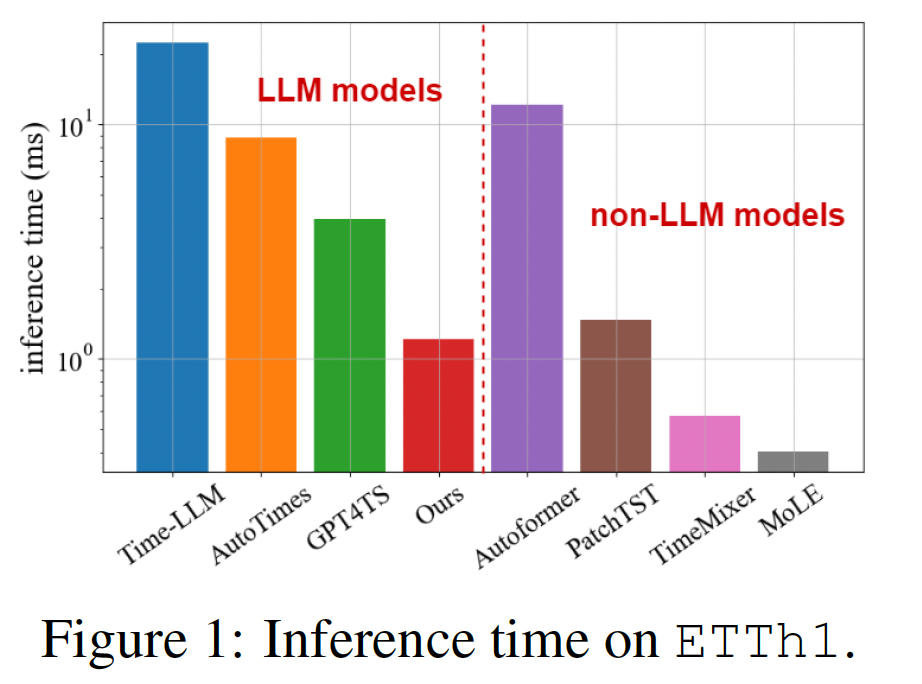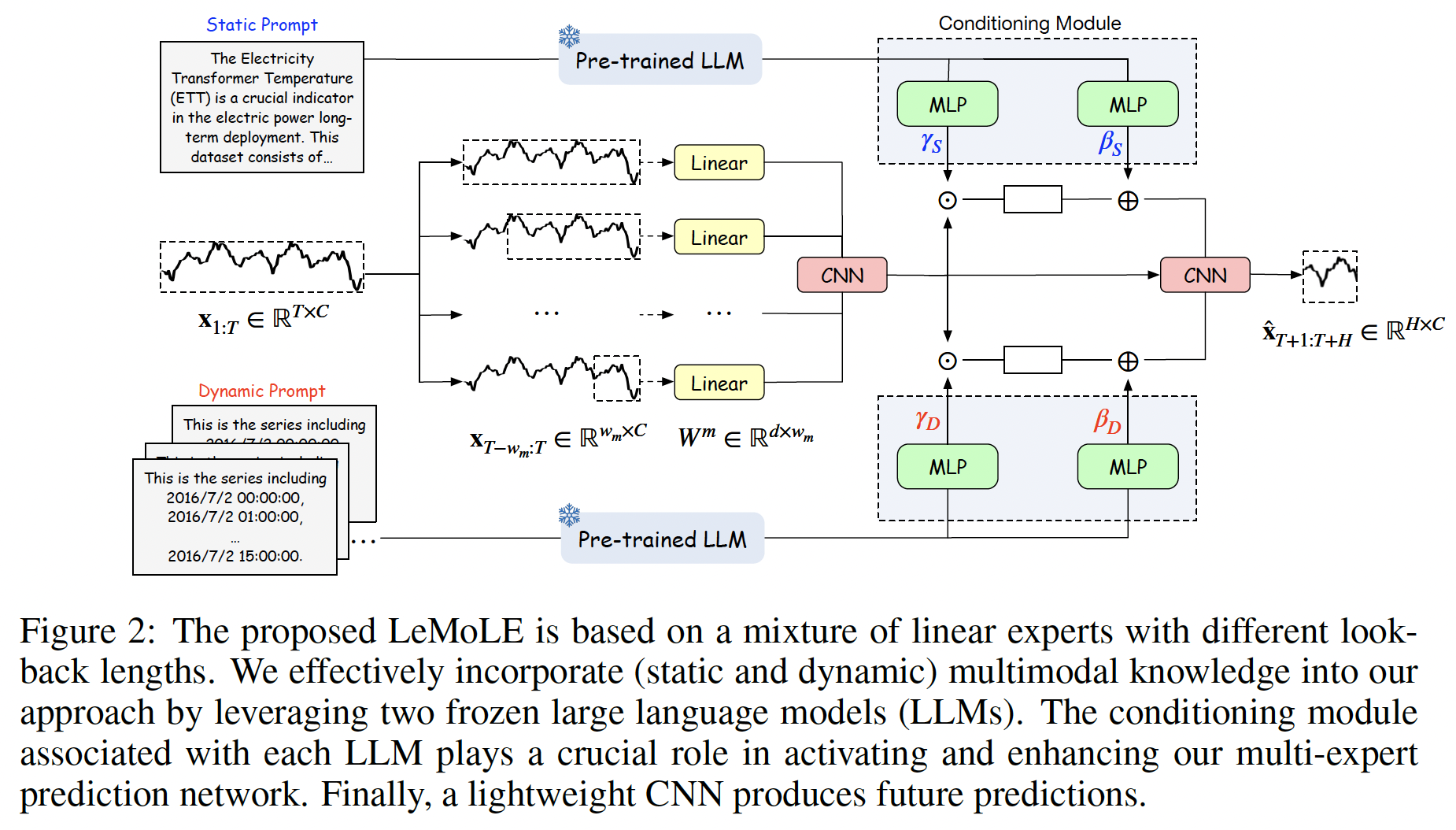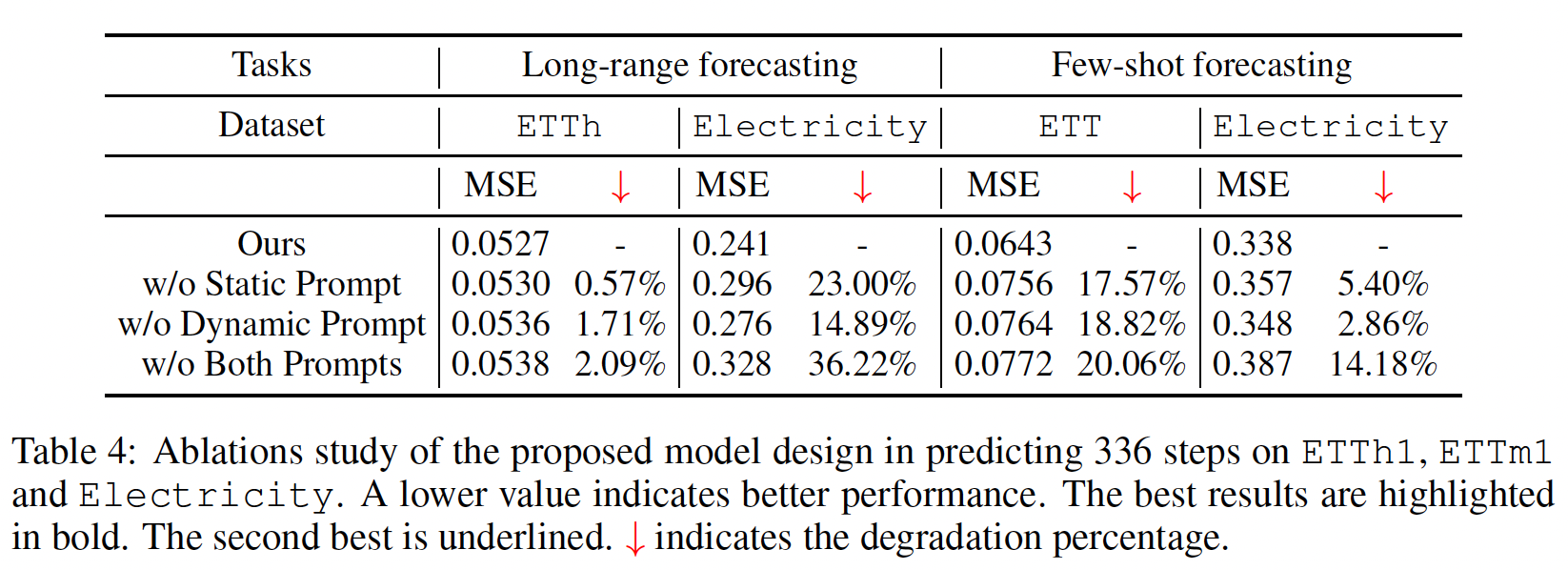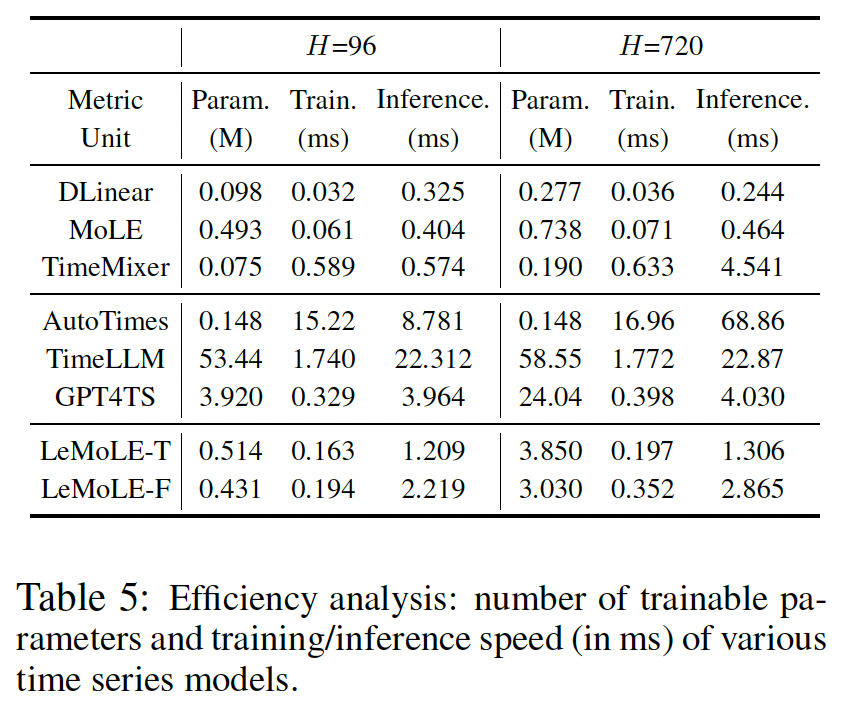LeMoLE: LLM-Enhanced Mixture of Linear Experts for Time Series Forecasting
Contents
- Abstract
- Introduction
- Related Works
- LeMoLE
- Experiments
0. Abstract
Aligning TS into space of LLM: high computational cost
Proposal: LLM-enhanced mixture of linear experts
LeMoLE
-
(1) Mixture of linear experts with multiple lookback length (\(L\))
\(\rightarrow\) Efficient due to simplicity
-
(2) Multimodal fusion mechanism
\(\rightarrow\) Adaptively combines multiple linear experts based on the learned features of text modality
1. Introduction
(1) Trend 1: Linear model
-
Have been outperforming in TS domain, while maintaining efficiency
-
Nontheless, limitations:
-
(1) Non-linear patterns
-
(2) Long-range dependencies
-
\(\rightarrow\) Mixture of linear experts
- e.g., some focus on trend, some handle seasonalities …
Mixture-of-Linear-Experts (MoLE)
-
Train multiple linear-centric models (i.e., experts) to collaboratively predict TS
-
Router model
-
Accepts a timestamp embedding of input sequence as input
-
Learns to weight these experts adaptively
\(\rightarrow\) Allows different experts specialize in different periods of TS
-
(2) Trend 2: Multimodal knowledge

Proposal: LeMoLE
LLM-enhanced mixture of linear experts
Difference with MoLE
- (1) Enhances ensemble diversity by leveraging experts with varying \(L\)s
- handle both short & long term temporal patterns
- (2) Multimodal knowledge
- From global & local text data
- Allows LeMoLE to allocate specific experts for specific temporal patterns
- (3) Incorporate static & dynamic text information
- Two conditioning moudles (based on FiLM, 2018)
Contributions
-
LeMoLE: based on (1) mixture-of-expert learning & (2) multimodal learning
-
Linear experts with varying \(L\) for diversity
( + incorporate 2 conditioning modules to effectively integrate global & local text info )
-
Rethinkg existing LLMs for TS
2. Related Works
(1) Linear Models
TimeMixer (2024)
- Mix the decomposed season & trend components from multiple resolution
- Multiple predictors
MoLE (2024)
- Multiple linear experst
- Based on a router module
- to adaptively reweight experts’ output for final prediction
- (proposed) LeMoLE = MoLE + Multimodal fusion mechanism
(2) LLM-based Multimoal Forecasting
Main challenges: Misalignment in modalities
3. LeMoLE: LLM-Enhanced Mixture of Linear Experts
Problem Formulation
-
Lookback window: \(\mathbf{X}_{1: T} \in \mathbb{R}^{T \times C}\)
-
Forecast window: \(\mathbf{X}_{T+1: T+H}\)
-
Model: \(\mathbf{X}_{T+1: T+H}=\mathcal{F}^*\left(\mathbf{X}_{1: T}\right)\)
- Prompts:
- Static prompt: \(\mathbf{P}_S\)
- Dynamic prompt: \(\mathbf{P}_D\)
- Model with prompts: \(\hat{\mathbf{X}}_{T+1: T+H}=\mathcal{F}\left(\mathbf{X}_{1: T}, \mathbf{P}_D, \mathbf{P}_S\right)\).
Overall Architecture

(1) MoLE
\(\mathbf{Y}^{(m)}=\mathbf{W}_m \mathbf{X}_{T-w_m: T}+\mathbf{b}_m,\).
- where \(m=1, \ldots, M\)
- \(\mathbf{W}_m \in \mathbb{R}^{H \times w_m}\) and \(\mathbf{b}_m \in \mathbb{R}^{H \times C}\) are trainable expert-specific parameters.
Obtain \(M\) prediction output from \(M\) linear experts
\(\rightarrow\) Denoted by \(\left\{Y^{(1)}, Y^{(2)}, \ldots, Y^{(M)}\right\}\).
(2) LLM-enhanced Conditioning Module
For prompting, essential to design ..
- a) Appropriate text prompts
- b) Corresponding conditioning module to activate the multi-expert prediction network
TS data: two types of text info
- (1) Static text
- Global information about TS
- e.g., Data source description
- (2) Dynamic text ( time-dependent )
- Local information about TS
- e.g., time stamps, weather conditions ..
a) Static prompt \(\mathbf{P}_S\)
\(\mathbf{P}_S\) = Contains the \(L_S\) length of texts (including punctuation marks)
\(\mathbf{Z}_S=\mathcal{L} \mathcal{L M}\left(\mathbf{P}_S\right)\).
- Text representation vector \(\mathbf{Z}_S \in \mathbb{R}^{L_S \times d_{l l m}}\),
b) Dynamic prompt \(\mathbf{P}_D\)
Timestamps in the datasets
- Follow AutoTimes (Liu et al., 2024b) to use the timestamps as related dynamic text data
Aggregate textual covariates \(\mathbf{T}_{T-w_1}, \ldots, \mathbf{T}_T\) to generate the dynamic prompt as \(\mathbf{P}_D \in \mathbb{R}^{L_D \times 1}\).
\(\mathbf{P}_D=\operatorname{Prompt}\left(\left[\mathbf{T}_{T-w_1}, \mathbf{T}_{T-w_1+1}, \ldots, \mathbf{T}_T\right]\right)\),
\(\mathbf{Z}_D=\mathcal{L} \mathcal{L} \mathcal{M}\left(\mathbf{P}_D\right)\).
(3) Conditioning Module
Use the prompts as conditions to activate our multi-expert prediction network.
- \(\mathbf{Z}_S \in \mathbb{R}^{L_S \times d_{U m}}\) and \(\mathbf{Z}_D \in \mathbb{R}^{L_D \times d_{U m}}\)
Two conditioning modules
- To fuse \(\mathbf{Z}_S\) and \(\mathbf{Z}_D\) respectively
- Based on the popular conditioning layer, FiLM (Perez et al., 2018)
- Use a CNN to map the multi-linear experts’ outputs \(\left\{\mathbf{Y}^{(1)}, \mathbf{Y}^{(2)}, \ldots, \mathbf{Y}^{(M)}\right\}\)
- \(\mathbf{Y}=\operatorname{CNN}\left(\left[\mathbf{Y}^{(1)} ; \mathbf{Y}^{(2)} ; \ldots ; \mathbf{Y}^{(M)}\right]\right)\).
- Step 1) \(\mathbf{Y}_S^{\prime}=\gamma_S \odot \mathbf{Y}+\beta_S\)
- Step 2) \(\mathbf{Y}_D^{\prime}=\gamma_D \odot \mathbf{Y}+\beta_D\)
Final prediction
- Light-weight CNN blocks to summarize all branches
- \(\hat{\mathbf{Y}}=\operatorname{CNN}^{\mathrm{final}}\left(\left[\mathbf{Y} ; \mathbf{Y}_S^{\prime} ; \mathbf{Y}_D^{\prime}\right]\right)\).
Loss function: \(\mathcal{L}= \mid \mid \mathbf{x}_{T+1: T+H}-\hat{\mathbf{Y}} \mid \mid _2^2\).
4. Experiments



